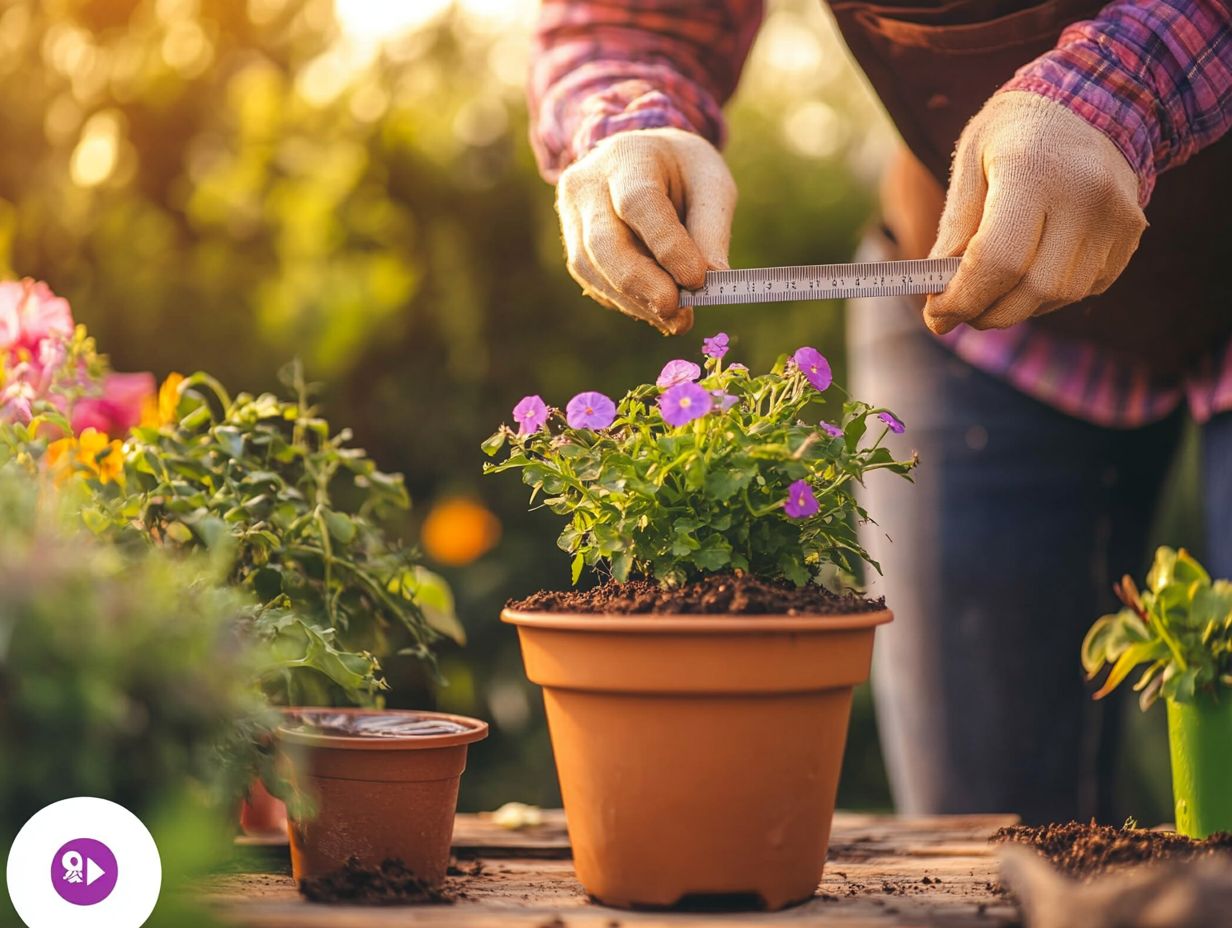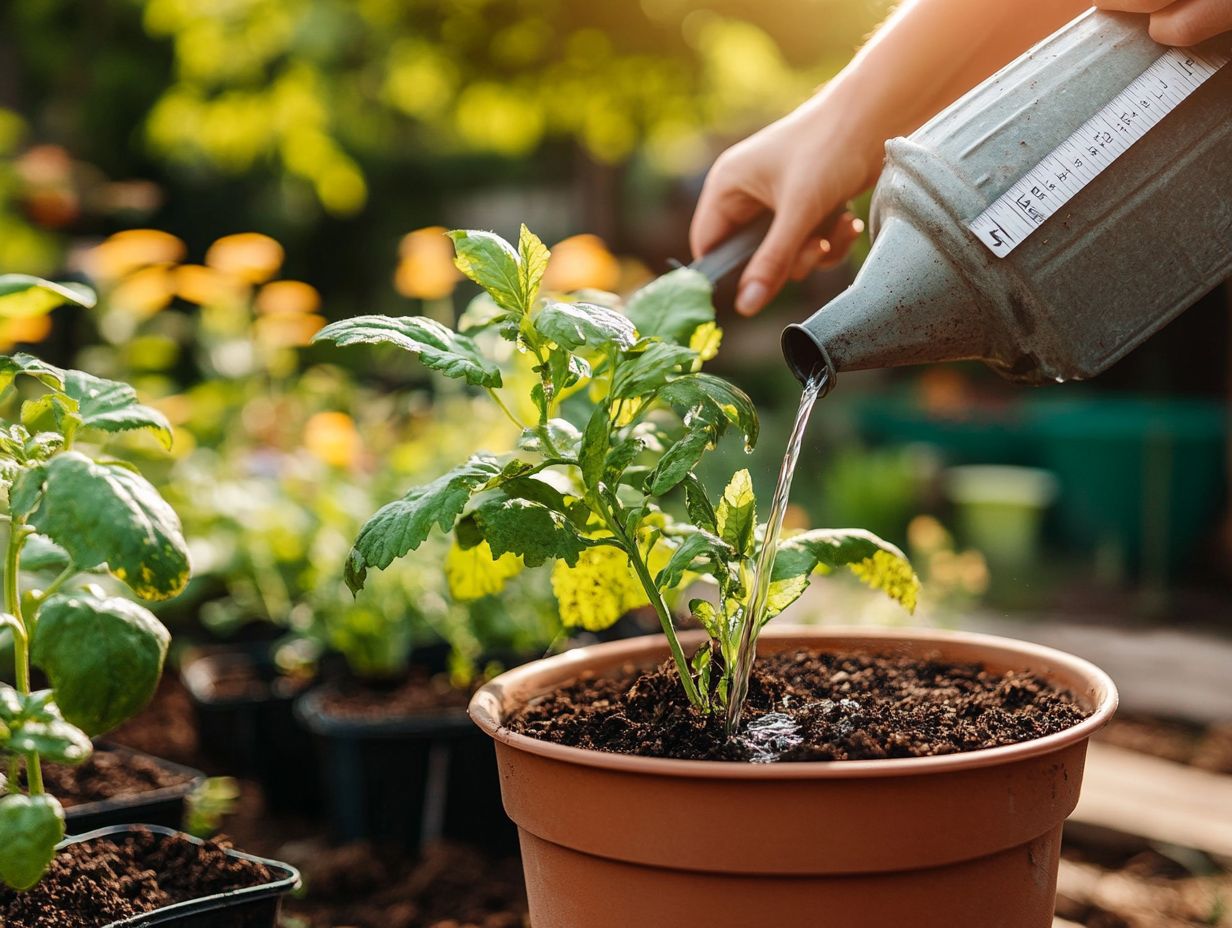The Future of Sustainable Travel Destinations
Watering your potted plants goes beyond a simple task; it s an art form. Understanding how deeply to water is key to your plants’ health.
In this guide, you ll discover why watering depth matters, what factors influence it, and how to find the right level for various plants. You’ll also learn practical tips for proper watering habits while avoiding common mistakes.
Dive into this guide and unlock the secrets to nurturing your plants!
Contents
- Key Takeaways:
- The Importance of Watering Depth for Potted Plants
- Factors Affecting Watering Depth
- How to Determine the Right Watering Depth
- Tips for Properly Watering Potted Plants
- Common Mistakes to Avoid
- Frequently Asked Questions
- What is the importance of understanding how deep to water potted plants?
- How often should I water my potted plants?
- What is the best way to determine how deep to water my potted plants?
- Can I use the same watering depth for all my potted plants?
- What happens if I overwater my potted plants?
- Is it possible to underwater my potted plants?
Key Takeaways:

- Proper watering depth is crucial for the health and growth of potted plants.
- Factors like plant type, pot size, and climate can affect the necessary watering depth.
- To determine the correct watering depth, use methods like checking soil moisture and adjusting for different plant needs.
The Importance of Watering Depth for Potted Plants
Understanding the importance of watering depth is vital for your potted plants. It helps maintain their health and vitality.
When you water your indoor or outdoor plants, the depth at which the water penetrates the root ball the mass of roots and soil at the base of a plant plays a crucial role in their growth and resilience.
Proper watering techniques improve soil moisture levels. This ensures that your plant roots absorb the water they need. This knowledge extends beyond just potted plants; it s fundamental for container gardening, where moisture retention is key.
The right watering depth helps you avoid problems like root rot, which can arise from overwatering, making it essential for successful plant care.
Why Does Watering Depth Matter?
Watering depth is crucial because it directly influences the health and growth of your plants. Understanding how deep to water ensures that your plant roots receive the right amount of moisture, avoiding the pitfalls of overwatering or under-watering.
Keep in mind that indoor and outdoor plants may have different watering frequencies based on their species and environmental conditions. By ensuring that water penetrates down to the root ball, you optimize nutrient absorption and foster robust plant care.
Improper watering depth can lead to stunted growth or root rot, especially in delicate species like succulents and orchids that flourish in well-drained environments. For instance, succulents thrive on a simple rule: water only when the top inch of soil is dry. Orchids, on the other hand, need regular yet shallow watering to keep their roots from sitting in water.
Over-saturated soil can suffocate roots and invite fungal issues, causing leaves to yellow and drop prematurely. Conversely, if you neglect to water deeply, essential nutrients may never reach the roots, leaving plants like tomatoes and peppers struggling to yield a healthy harvest, ultimately jeopardizing their vitality.
Factors Affecting Watering Depth
Several factors influence the ideal watering depth for your plants, including the types of plants, soil moisture retention, and climate conditions.
For example, different species like succulents necessitate unique watering practices due to their specialized root structures and moisture absorption abilities. Additionally, environmental elements such as humidity levels and evaporation rates significantly impact how deeply you should water.
By grasping these factors, you can develop a customized watering schedule that precisely meets the needs of both your indoor and outdoor plants.
Type of Plant and Pot Size
The type of plant you choose and the size of its pot are crucial elements in determining the ideal watering depth. Different plants, like Snake Plants or Ficus benjamina, have unique watering needs influenced by their root systems and how well they hold water. The pot size plays a significant role in how water is absorbed and retained in the soil. A larger pot may necessitate deeper watering to ensure the roots can access moisture, while smaller pots might require more frequent watering to prevent waterlogging.
To customize your watering strategy, consider both the pot dimensions and the plant’s growth habits. For example, plants with shallow root systems thrive with a lighter approach, allowing the top inch of soil to dry out before watering. In contrast, plants with deeper roots benefit from saturating the soil to a more substantial depth. For more detailed guidance, explore watering techniques for newly potted plants.
A practical method is to use a moisture meter or the finger test to determine the right depth. Simply stick your finger into the soil and check how far down it feels dry. This way, you can fine-tune your watering schedule, ensuring that each plant flourishes according to its specific needs.
Climate and Environment

Climate and environmental factors are crucial for determining how deeply you should water your plants. In scorching climates like Arizona, the summer heat ramps up soil evaporation, making it essential to water deeply enough for moisture to reach the root ball effectively. Humidity levels around you can also dictate how often and how deeply you should water, guiding you to regularly check soil moisture and adjust your watering habits accordingly.
As temperatures soar, paying close attention to how the soil reacts to the heat becomes vital. While keeping a consistent watering schedule is important, remember that different plants have varying water needs.
To accurately monitor environmental conditions, consider investing in a soil moisture meter. This awesome tool makes watering a breeze! On particularly hot days, watering early in the morning or later in the evening can significantly cut down evaporation losses.
Watch your plants foliage closely; if the leaves begin to droop or discolor, act now to adjust your watering depth and frequency to maintain the optimal hydration necessary for vibrant, healthy growth.
How to Determine the Right Watering Depth
Determining the optimal watering depth for your plants requires a keen understanding of soil moisture levels and the application of various techniques to measure it accurately.
Employing tools such as moisture meters allows you to assess the moisture content in your potting soil, enabling you to customize your watering schedule with precision.
By ensuring that water penetrates deep enough to reach the roots, you not only foster healthy growth but also avert potential issues like root rot or under-watering.
Methods for Measuring Soil Moisture
Numerous effective methods exist for measuring soil moisture, each serving a crucial role in perfecting your watering techniques. One of the most popular tools at your disposal is the moisture meter, which delivers precise measurements of moisture levels in the soil. This handy device helps you decide when it’s time to water your plants.
Incorporating various watering methods, such as using a soaker hose a type of watering tool that delivers water directly to the soil or a traditional watering can, can further enhance your watering strategy. Mastering these tools can significantly elevate your plant care routine and enhance the overall health of your potted plants.
Beyond moisture meters, you can also employ manual techniques like the finger test, where you simply insert your finger into the soil to assess its dampness. While this method is straightforward, it might overlook moisture deeper in the soil.
On the tech-savvy side, automated irrigation systems equipped with soil moisture sensors can optimize your water usage, ensuring that your plants get precisely what they need no more, no less thus preventing overwatering.
By incorporating these techniques, you can efficiently manage your water resources, fostering healthier growth and minimizing the risks of root rot or drought stress. This approach not only promotes optimal plant care but also elevates your gardening game to a whole new level, enhancing both your indoor and outdoor gardening experiences.
Adjusting Depth for Different Plants
Adjusting the watering depth based on the specific needs of your plants is crucial for promoting healthy growth and achieving success in container gardening. For instance, succulent plants thrive with shallower watering depths because they excel at storing moisture in their leaves. On the other hand, larger plants often require deeper watering to ensure their root systems are properly hydrated. By adapting your watering practices according to the types of plants you have, you can significantly boost their overall health and vitality.
Take tropical plants, for example: they thrive in consistently moist conditions and benefit from deeper watering to reach their extensive root networks. Meanwhile, herbs may only need a few inches of water applied more frequently. Check the top inch of the soil regularly! It tells you when to water; if it feels dry, it s likely time to water. Also, keep an eye on any changes in foliage, like wilting or yellowing leaves, as these can be telling signs that your approach needs adjustment.
Tailoring your watering practices not only enhances growth but also creates a more vibrant and rewarding gardening experience.
Tips for Properly Watering Potted Plants
To properly water your potted plants, you need to grasp the right frequency and amount of water suited for each plant type, ensuring their health and vitality. Developing a well-structured watering schedule will help you maintain optimal soil moisture levels, allowing the roots to flourish. It s crucial to pay attention to the signs of overwatering or underwatering, as these can lead to serious issues like root rot and stunted growth.
Frequency and Amount of Watering

Determining the right frequency and amount of watering is essential for maintaining the health of your potted plants. Each plant type comes with its unique set of needs; for example, succulent plants typically require less frequent watering, while thirstier varieties like Dracaena or Golden Pothos crave more moisture. By establishing a consistent watering schedule tailored to your plants’ ability to hold water, you’ll set the stage for optimal plant care.
To craft a personalized watering plan, consider not only the types of plants you have but also other factors like pot size and local climate. Larger pots tend to hold moisture longer than their smaller counterparts, meaning plants in those bigger containers may not need watering as often. In warmer climates, evaporation rates soar, prompting a greater need for hydration.
For instance, if you have a Boston Fern basking in a warm, bright spot, it may thrive with a more frequent watering routine compared to a Snake Plant lounging in a cooler, shaded nook. Monitor the topsoil’s dryness and adjust your schedule as needed, ensuring that each plant in your collection flourishes beautifully.
Signs of Over or Under Watering
Recognizing the signs of over or under watering is crucial for maintaining the health of your plants and ensuring proper watering techniques.
If you notice that the leaves are turning a dull yellow and feel soft to the touch, this could indicate excessive moisture in the soil. Conversely, when the leaves become brittle and start to curl, it often suggests a lack of water.
Fix overwatering by ensuring good drainage and reducing your watering frequency. If you notice under watering, a quick fix would be to gradually increase the water intake to restore moisture levels without shocking the plant.
By swiftly recognizing these signs and intervening promptly, you not only enhance your plants’ vitality but also protect them from long-term damage, setting the stage for robust growth and improving your overall garden landscape. Act fast to save your plants!
Common Mistakes to Avoid
Avoiding common mistakes in your watering practices is essential for the health of your plants. Improper techniques can lead to issues like root rot and stunted growth.
One frequent pitfall is overwatering. Many gardeners mistakenly believe that more water means healthier plants, which can have serious consequences for plant roots.
By understanding proper watering habits like how deep to water your plants and how often you can prevent these issues and grow a healthy garden.
Effects of Improper Watering
Improper watering can seriously affect plant health. If your watering habits don t match your plants’ needs, you risk creating overly saturated soil or not providing enough moisture. Both scenarios can be harmful.
For instance, consider a community garden where inconsistent watering led to problems. Many plants suffered from fungal infections due to too much moisture, leading to disappointing harvests.
In a study on hobbyist gardeners, it was noted that plants with erratic watering showed stunted growth and poor yields. These examples highlight the importance of a regular watering schedule tailored to your plants’ specific needs.
By establishing this routine, you can avoid negative effects and promote sustainable gardening practices that lead to thriving plants.
Frequently Asked Questions
What is the importance of understanding how deep to water potted plants?

Knowing how deep to water is crucial for your plants’ health. Overwatering can cause root rot, while underwatering can lead to wilting.
How often should I water my potted plants?
The frequency of watering depends on the type of plant, pot size, and environmental conditions. Typically, potted plants should be watered when the top inch of soil feels dry.
What is the best way to determine how deep to water my potted plants?
A good rule is to water until you see drainage at the bottom of the pot. This ensures that the roots are getting enough moisture.
Can I use the same watering depth for all my potted plants?
No, different plants have different needs. For example, succulents require less water and shouldn’t be watered as deeply as other plants.
What happens if I overwater my potted plants?
Overwatering can lead to root rot, which occurs when roots are submerged in water and lack oxygen. This can cause wilting, yellowing leaves, and even death. Make sure to let the soil dry between waterings to prevent this.
Is it possible to underwater my potted plants?
Yes, underwatering can also harm your plants. If the soil is dry and the plant looks wilted, it indicates a lack of water. Always check your plants’ specific needs to avoid this issue.
Don’t let your plants suffer! Start watering right today for a healthier garden tomorrow!






